FESTIVALPROGRAMM BLOG
AUSZÜGE IN DEUTSCHSIMPLICITY - the art of complexity - ARS ELECTRONICA 2006 - Festival für Kunst, Technologie und Gesellschaft - Linz, Do 31. August – Di 5. September
26
Jun
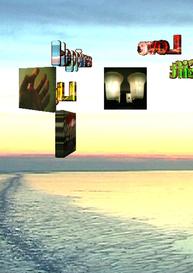 © Jürgen Scheible
© Jürgen Scheible
Word in Space is an audience participatory art installation that invites people to use their mobile phone to post a word or image into a 3D space onto a large public display. The posted words float slowly in the screen space as 3D text, images as textures on small cubes, rotating around their X or Y axis , retreating gradually from the picture plane over time.
The idea of this work originates from the German idiom "Ein Wort in den Raum stellen" meaning to "put a word up for discussion and thought".
By creating graphical objects, the audience can place their thoughts into space, which then can be observed visually. This allows meditating on them, letting the mind wander round, still helping to keep the focus. At the same time, the words and images posted by other people can spark new thoughts in each viewer’s own thinking, connecting the minds.
The fading away of the objects into an ethereal space might remind the viewer that our human lives, too, will one day fade away - from the real space to where?
Word in Space: Jürgen Scheible (Artist: Lenin’s Godson)
25
Jun
Jürgen Scheible (Artist: Lenin’s Godson), Germany, a Researcher, Engineer and Media-Artist. He is a PhD candidate at Media Lab, Univ. of Art & Design, Helsinki and was a visiting scientist at MIT, USA. 2006 he became a Forum Nokia Champion, being a bridge builder between art & engineering.
Jürgen Scheible: Lenin's Godson's MobileArtBlog
25
Jun
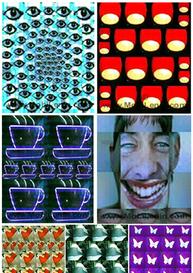 © Jürgen Scheible
© Jürgen Scheible
The MobileArtBlog is a blog of digital art images created with a mobile phone. It is the travel journal of artist Lenin’s Godson. Instead of ordinary images and text, this blog holds a collection of popart images, each in phone screen size, which the artist creates out of stimulating experiences along his travels. Inspired by shapes, colours and forms of objects in different cities, places and situations, he attempts to capture the moment by turning it into a memorable art piece on the spot.
By using Python on the phone for making collages through taking a photo, resizing, copying and placing it freely on the canvas, the art image is instantly created and uploaded incl. GPS data.
Fans and art lovers can receive the images in real . time via a Konfabulator widget or RSS feed on their PC or mobile, enabling instant sharing on a global scale.
People can instantly rate an image, triggering feedback to the phone of Lenin’s Godson making it vibrate. Among the views of the imagery on his blog is a Google map, marking where the artist has travelled.
Lenin's Godson's MobileArtBlog: Jürgen Scheible (Artist: Lenin’s Godson)
24
Jun
Johanna Höysniemi (FI) is a media art student who is finalizing her Ph.D thesis in the field of physically interactive computer games. Her thesis focuses on the design and evaluation of embodied games and studies the phenomenon of gaming as a public performance.
Perttu Hämäläinen (FI) research scientist/interaction designer. D.Sc.(Tech) (2006), MA in New Media (2002), University of Art and Design Helsinki Media lab, Finland. M.Sc.(Tech) (2001), Helsinki University of Technology, Department of Electrical and Telecommunications engineering, Finland. Projects and publications: www.tml.tkk.fi/~pjhamala
Johanna Höysniemi & Perttu Hämäläinen: QuiQui’s Giant Bounce
24
Jun
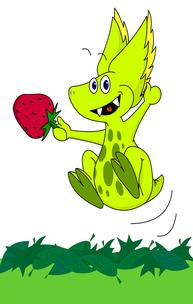 © J. Höysniemi & P. Hämäläinen
© J. Höysniemi & P. Hämäläinen
QuiQui's Giant Bounce is a physically and vocally interactive computer game aimed at 4 to 9 year old children. The game is not controlled using a joystick or a keyboard. Instead, the user's body movements and voice are sensed via a webcam and a microphone.
The main character QuiQui is a curious little green dragon that mimics the user's movements and shouts and exhales sparkles when the user shouts. The game is based on research on children's physical development, augmented with usability tests and interviews at schools and daycare centers. The goal is to provide an immersive and physically engaging alternative to traditional computer games: QuiQui activates children to use their whole body and develops their physical abilities like coordination and balance. The ways of moving in a game are motivated by an enticing storyline and rich audiovisual content. The game features technological innovations that enable physical interaction in every home. Compared to games based on sensory devices like a dance mat, QuiQui's user interface is full-body and wireless.
QuiQui’s Giant Bounce: Johanna Höysniemi, Perttu Hämäläinen
23
Jun
Zeenath Hasan (IN) is an independent media designer / researcher practicing design for development. She exercises the potential of mobile information and communication technologies to facilitate grassroots activities and networks.
Richard Widerberg (SE) is a media-artist and musician working mostly with sound-related projects. His practice involves investigating the many dimensions of sound as well as making live performances based on his recordings.www.riwid.net
Richard Widerberg & Zeenath Hasan: IMPROVe
23
Jun
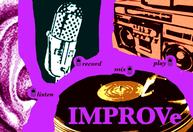 © Antti Ahonen
© Antti Ahonen
IMPROVe is an aural architecture for socio-cultural exchange. Sonic realities of the everyday are improvised live in a non-linear mode.
IMPROVe explores the role of the mobile phone user as a creator of her/ his own content. It attempts to define the mobile device as a tool for environment awareness by making the user conscious of their immediate sonic surrounding.
Scenario
A group of friends record sound objects and soundscapes from their daily life through a mobile device. The group meets in a local pub with a soundsystem. Here they perform a live-remix of the sounds on their mobile devices. Through the sonic improvisation of their everyday soundscape, they affect their experience of the here and the now.
Functionality
IMPROVe collects sound via a mobile device and sends them to a location where they can be played back into a soundsystem. The same mobile device controls the playback of the collected sounds in the soundsystem. Playback control occurs in the physical location of the soundsystem. The playbacked sounds are processed live via interaction on the mobile device. The output of the processed sound can be directly heard through the soundsystem.
IMPROVe: Richard Widerberg & Zeenath Hasan
Development Partners: MAHITI
Project Partners: Åsa Ståhl, Kristina Lindström
22
Jun
Viki Ølgod (DK) has during the last years focused into intermediated communication tools and the social impact of those on modern interactions patterns.
Viara Gentchev (CA) explores what she calls ‘digital reconstructions’ of iconic representations in which questions of technological progress, ethics, authorship and originality are intertwined.
Ksenia Avetisova was born in the Southern Russia in 1983. She has an experience of studying and work in Russia, USA and Finland. Currently involved in a number of international projects among which is the interactive media installation “The EyeSight”.
Viki Ølgod, Viara Gentchev & Ksenia Avetisova: The Eyesight Project
22
Jun
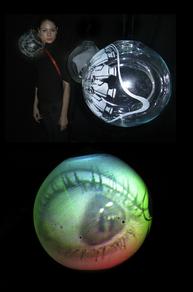 © Solarhive.com
© Solarhive.com
The Eyesight Project is an interactive sculpture created to increase the awareness of our post-modern approach to surveillance. Visibility in a way replaces force as a tool of control, we ask ourselves what the contemporary definition of privacy is or may become in the future.
Eyesight’s concept explores the archetype of total surveillance; a way to improve discipline in society such as the architectural form invented in the early 1780 by Samuel Bentham (Panopticon).
The idea of a closed circuit television system monitored by a handful of functionaries is one way for our contemporary mind to grasp the idea.
In a world of constant society driven need for security, surveillance becomes the calming factor in achieving this inner peace and thus, a familiar part of our daily life. The installation displays the omni-present icon of surveillance: the eye in the sky. As a spectator trying to grasp the pulse of the surveillance society the installation visualizes the never encountered observer.
The Eyesight Project: Viki Ølgod (DK), Viara Gentchev (CA), Ksenia Avetisova (RU)
21
Jun
Kalle Määttä is an MA student in UIAH Media Lab. He also holds a M.Sc. degree in geography. Besides studies Kalle has been working on the cutting edge of mobile interactive media and entertainment for years, holding such positions as CEO, Creative Director and Game Designer.
The Global Dignity Project is an international group working to increase dignity in globalisation. The group was started by Prof. Pekka Himanen, Crown Prince Haakon, and activist John Bryant
Kalle Määttä: Dignity Nation / Global Dignity Project
21
Jun
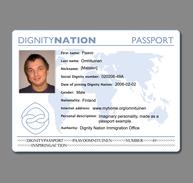 © Kalle Määttä
© Kalle Määttä
Dignity Nation is a movement and community created around the Dignity Principles introduced in Global Dignity Project www.globaldignity.org. The goal of the Nation is to create such a force that the voice of dignity can be heard even on the highest levels of power!
The mission of the Dignity Project is to implement globally the universal right of every human being to lead a dignified life. By signing the five Dignity Principles (introduced under http://globaldignity.org/index.php) you express your adoption of these principles for your action. To give your voice also a face, you also become a 'citizen' of the virtual Dignity Nation, where your name is shown along with your picture. It's not a real country but a community that exists to concretize the idea that you belong to a group of people that calls for more dignity in our world.
Dignity Nation / Global Dignity Project: Kalle Määttä
20
Jun
The Equilibrium Project was created by Media Arsonists, a free experimentation group based in Helsinki, Finland. The group consists of Dominic Leskinen and Lauri Huikuri, both students at the Media Lab, University of Art and Design Helsinki.
Media Arsonists: Equilibrium
20
Jun
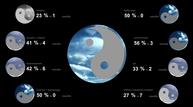 © Media Arsonists
© Media Arsonists
This project is a visual representation of the balance of "power" or state of equilibrium in the world. The visualisation is based on live news feeds, which are refreshed in real-time in 12-24 hour periods.
News articles from live RSS feeds, such as BBC World and CNN are passed through a PHP server, which obtains a set of results for each article's content.
We use Google API searches with positive/negative keyword sets to determine the 'contemporary' value of the news. I.e. If the number of search results that Google returns from the news article is higher for positive keywords, then the article gets a percentage of 50-100, or 0-50 conversely.
The results from Google are based on a cross-section of the current Internet population's views. And therefore are not necessarily biased or attached to any particular political, national or regional model.
Each article is categorised using a set of specific keywords, The category which yields the highest number of search results becomes the article's category.
The purpose of this project is to provide a live and changing picture of global news trends that influence our everyday lives. In a sense it's like a clock, but rather than show the time, it shows the direction or state of current affairs. Equilibrium.
Equilibrium: Media Arsonists
19
Jun
Meeri Mäkäräinen was born in 1982 in Pudasjärvi, Finland. She has studied
at UIAH since 2001 (Media Lab since 2005) and at Helsinki University of
Technology since 2002. She works as a research assistant at Helsinki
University of Technology.
Meeri Mäkäräinen: Ruby
19
Jun
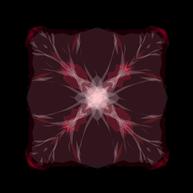 © Meeri Mäkäräinen
© Meeri Mäkäräinen
Ruby is a computer program that produces an animation of a gemstone brought to life. The program performs a physical simulation of two elastic membranes vibrating in an environment where the laws of physics have been modified. In a perfect physical simulation vibrating membranes would gradually lose their kinetic energy due to resistant forces. In this simulation, however, membranes gain energy from vibration instead of consuming it. The extra energy is a source of complex emergent behaviour of the membranes - the membranes make movements that could not have been predicted.
The simulation is visualised with an animation in which two translucent square shaped membranes vibrate together. The membranes are rendered with polygons, which is why we see angular forms.
The angular look of the polygons combines with the organic nature of the elastic membranes to create a continuous metamorphosis between a faceted gemstone and a flourishing flower.
Ruby: Meeri Mäkäräinen
18
Jun
Kristian Simolin – Visual Artist and 3D-animator based in Helsinki. Explores 3D character animation as a medium for artistic expression. Works range from interacticve installations to web based real-time projects.
Pauli Laine – Musicologist, PhD, composer. Investigates music through cognitively inspired algorithmic generative methods which can also be used as a tool in composition. Pauli has worked in several research positions in academia and industry.
Kristian Simolin & Pauli Laine: Joutokäynti – Idle Running
18
Jun
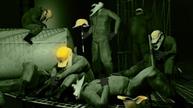 © Kristian Simolin
© Kristian Simolin
Joutokäynti – Idle Running is an animated media art work by Kristian Simolin and Pauli Laine.
The centre stage is given to a group of workmen, who have been placed in simplified, industrial surroudings. Each of the workmen repeat their individual, restless and inward movement, which changes only a little when repeated. The rhythm and the repeated movements of the characters together with the soundtrack form a hypnotic rhythm. In the animation, the world is formed of a little, standing-still moment that continues forever. The characters are in constant move, but the movement does not have a goal.
The starting point of Idle Running's animated movements are those small repetitive motions people make when they are nervous or frustrated: the rhythmic tapping of the foot or the hand, or the fiddling about with an object or a garment. Tiny movements like these form a restless world of motions characteristic of queues, public transport, and waiting rooms. The psychological meaning of the small, recurring movements is adaptation to oppressing surroundings and situations.
Joutokäynti – Idle Running: Kristian Simolin and Pauli Laine
17
Jun
Markku Nousiainen (b.1970) is a concept designer and media artist. He has study backgrounds in digital media and engineering, and is especially interested in using audiovisual media in connection with performing arts.
Markku Nousiainen and workgroup: UMBRA – Creating Theatrical Illusions with Digital Media
17
Jun
Campus | posted by GerdaHinterreiter | at 09:15:00
UMBRA – Creating Theatrical Illusions with Digital Media
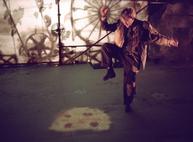 © Markku Nousiainen
© Markku Nousiainen
Umbra is a dance performance where live performers meet a virtual world created with the aid of digital media. It’s a fantasy tale inspired by old innovations and the aesthetics of magic lanterns and early cinema.
The story of Umbra is about an innovator who tries to accomplish a perpetual motion machine with the aid of his dance movements. He is assisted by a robot servant (actually, a small remote-controlled robot prototype). One day, the innovator is confronted by a stranger who enters his lab.
The style of the performance is determined by monochromatic silhouette animations, worn-out costumes and futuristic but rusty technology.
My motivation for the project was to experiment with different elements in storytelling: live dancers, virtual characters and virtual scenography, and a mechanical robot, to see how they can be combined. I wanted to create a performance reminiscent of the pre-cinema magic, but with today’s digital tools. The resulting performance is both highly technological and old-fashioned, in the sense that the projections have a role similar to that of traditional theatrical illusions.
Umbra is exhibited as a video installation.
Umbra: Markku Nousiainen and workgroup
16
Jun
Kati Åberg (Finland) is a media artist and producer who is interested in interdisciplinary art forms and in combining performing arts with new media. She has graduated from the Media Lab Helsinki and the Theatre Academy of Finland.
Kati Åberg: Emotions in Man
Blog Autoren:
Maria Hieslmayr Cornelia Sulzbacher Wolfgang Bednarzek Gerda Hinterreiter Didi Offenhuber Beta Lounge Artists Sonja Meller StWSt denCity.net
Suche:
Kategorien:
Conferences Animation Festival Events, Concerts & Performances Campus Exhibitions e-lobby Prix Ars Electronica
Recent Posts:
Photographs of the 2006 Festival Media lab thanks! Ars Electronica Center FM4 Live from Ars Electronica in Linz
Archiv:
Posts 80 - 60 Posts 60 - 40 Posts 40 - 20 Posts 20 - 0


